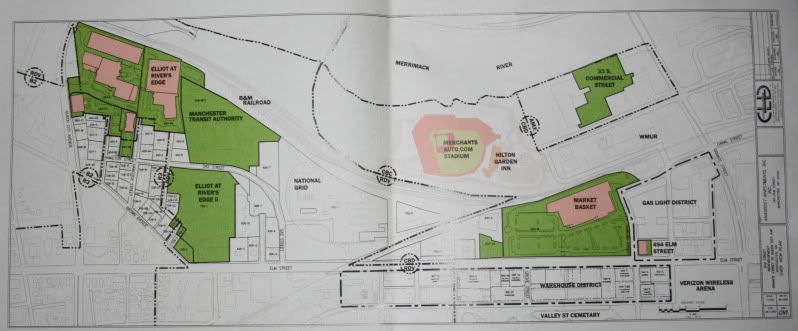Yeah I agree completely with what you say minus the "different look fro this area" I think it should just be a carry on of downtown Elm with the exception of newer buildings. Whatever is built should be built. Do not try to appeal to any theme. I would like to see some run down gas stations replaced (one will be with the MB)
I'm interested to hear your thoughts on "carrying on of downtown Elm" in the Warehouse District/South Elm area. My view is that it should be treated differently than downtown, but encourage people to move between the two areas. I'm not sure if we're thinking the same thing but expressing it differently, or if you have a different perspective on the area, but I'd like to hear more about it since it's an exciting area to imagine coming into its own.
Like I said, I think it should be treated differently. I found a
map of the area from 1905 that confirms what I had assumed about the area just from being there and the city naming it the Warehouse District. The streets aren't labeled, but you can see a big rail yard along the west side of Elm Street, which still exists in part but is also now the site of National Grid, Market Basket, etc. The opposite side of the street is home to the warehouses, many of which still exist though most have been poorly refaced along Elm with uninterested facades (fortunately, this is easily undone). You can also see that at the time the downtown proper really extended as far south as West Auburn, the east-west street with a kink in it just north of the rail yard that is now between the Gaslight District and MB. Old Granite Street was just regular Granite Street and followed the grid. When the Center of NH complex was built in the 1980s, several blocks were demolished and Granite Street was widened and re-routed. This created the much more defined end of downtown that exists now. So I think history supports treating the Gaslight, Warehouse and South Elm districts as distinct districts/neighborhoods that are very accessible and complimentary to downtown.
Additionally, I think the area just has an inherently different feel. Most of the buildings are much lower than those downtown, and given their industrial past they are much less ornate and don't feature the same type of storefront you find north of Granite Street. What I assume they do feature, however, are wide-span interior spaces similar to the mills that you won't find downtown, but in a much smaller scale than in the mills that would make them excellent conversions to retail, restaurants, bars and a few offices. Another thing that gives the Warehouse District a different feeling than downtown is that it is essentially a one-block deep neighborhood along one side of Elm Street. As I?ve mentioned, I?d have loved to see a larger, mixed-use development on the MB site, which would have blended the Gaslight and Warehouse districts and alleviated some of the single-sidedness of the Warehouse District. Still, I think the Warehouse District can use this to its advantage, but it has to embrace the rougher, industrial nature of the area to do so. It would be really odd to have taller buildings in the downtown mold facing an empty rail yard and supermarket parking lot; it?s not bad, though, to have lower-scale, reused industrial buildings (and new infill) facing what they always have: great views of the Uncanoonucs and hills across the river.
I agree the National Grid isn?t going anywhere and now that MB is going in, you?re going to have one side of Elm open and one with buildings, with an exception of hopefully replacing the auto-centric buildings at the end of Valley with something more urban. I?d like to see the city encourage National Grid and MB to do some landscaping on that side, but even without it, they?re sunken enough that the dominant view across Elm is really to the West Side, and given the width of Elm there it?s not like you?d have pedestrians running across the street anyway. More importantly, the city should plant a row of trees down the center of Elm as called for in the Master Plan to soften the strip feeling there. I?d also like to see the MTA run a frequent-service bus, perhaps an extension of the downtown circulator, between the Rivers Edge projects and downtown with stops in the Warehouse/South Elm. I?d be surprised actually if they don?t do this.
I really like your idea of re-using the buildings along the Willow side of the Warehouse District as residences?with the low traffic there, you could even have first-floor residences if developers chose, and they?d face a park-like cemetery backing onto what will hopefully be an exciting area. Additionally, I?d love to see the area retain some low-impact manufacturing. As far as I know, the only manufacturing left in the city center is happening in this neighborhood, and it?s pretty neighborhood-friendly: chocolate at Van Otis, furniture at Purely Wood, etc. Given the history of the neighborhood, the building stock and the proximity to the Gaslight district, which the city wants to see filled with more craftspeople I think, a component of light manufacturing (I?d love to see a microbrewery/brewpub in there) would really enhance the neighborhood. If you had a mix of this, some restaurants, shops, a few offices, and residences above and along Willow, the area could become a really hip, interesting neighborhood perfectly situated right by downtown and between it and the Rivers Edge redevelopment.

